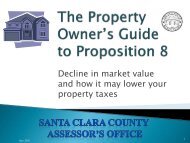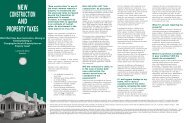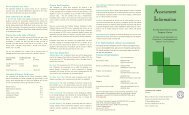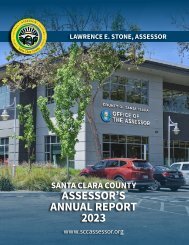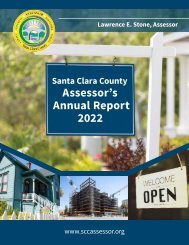Santa Clara County Assessor's Annual Report
Each year the Santa Clara County Assessor’s Office prepares an Annual Report available in hard copy and electronic versions. The report offers comprehensive statistical analysis of the local assessment roll, including all real and business property, legal exemptions, and assessment appeals. Assessment information is provided by property type, city, and school district. The Assessor’s Annual Report is an important source of information for public finance officials, real estate professionals, tax experts, academics, as well as business, government, and community leaders seeking insights into real estate trends in Santa Clara County.
Each year the Santa Clara County Assessor’s Office prepares an Annual Report available in hard copy and electronic versions. The report offers comprehensive statistical analysis of the local assessment roll, including all real and business property, legal exemptions, and assessment appeals. Assessment information is provided by property type, city, and school district.
The Assessor’s Annual Report is an important source of information for public finance officials, real estate professionals, tax experts, academics, as well as business, government, and community leaders seeking insights into real estate trends in Santa Clara County.
You also want an ePaper? Increase the reach of your titles
YUMPU automatically turns print PDFs into web optimized ePapers that Google loves.
Performance Counts
Led by County Assessor Larry Stone, the Assessor’s Office has implemented an ambitious performance-based
budgeting and management initiative. Based on the simple idea that what gets measured gets done, the Assessor’s
Office has a clear mission statement and measurable performance indicators designed to quantify improvement
over time, all tied directly to the budget.
Performance Measures
The following are the Assessor’s comprehensive performance measures for Fiscal Year 2020-21. By reporting
high-level quantitative and qualitative data that track levels of customer satisfaction, timeliness of product delivery,
accuracy of assessments and overall efficiency, these measures allow the Assessor to identify and record
service levels from year to year, designed to achieve specific continuous improvement objectives. The data is
compiled from the results of similar, more detailed measures in each Division of the Assessor’s Office. The performance
measures were developed in collaboration with both line staff and managers.
Property Assessment Monthly Calendar
Jan. 1: Lien Date
for next assessment
roll year.
This is the time
when taxes for
the next fiscal
year become a
lien on the property.
Feb. 15:
Deadline
to file all
exemption
claims.
Apr. 1: Due date for filing
statements for business personal
property, aircraft and boats.
Business property owners must
file a property statement each
year detailing the cost of all
supplies, machinery, equipment,
leasehold improvements,
fixtures and land owned at
each location within Santa
Clara County.
Apr. 10: Last day
to pay second installment
of second
property taxes without
penalty. This tax
payment is based on
property values determined
for the Jan.1
Lien Date of the year
prior.
1. Completed 99.1 percent of assessments
The assessment roll is the basis by which property taxes are levied. The completeness of the assessment roll
assures public agencies dependent upon property tax revenue that the assessment roll accurately reflects current
market activity.
2. Delivered supplemental assessments to the Tax Collector in an average of 171 days
Supplemental assessments occur upon a “change in ownership” or “new construction” of real property. This
performance measure ensures timely notification to those property owners who acquire or complete new construction
on their property.
3. Resolved all Assessment Appeals in an average of 640 days
By statute, assessment appeals must be resolved within two years of filing, unless a waiver is executed by the
taxpayer. This performance measure ensures a timely equalization of assessments for property owners. The average
number of days to resolve a residential appeal was 502 days.
4. Earned a 99.3 percent customer satisfaction rating from all office surveys
This outcome measures cumulatively the satisfaction level of both our internal and external customers who rely
on the Assessor for timely service and accurate information.
5. Managed resources with total expenditures at 96.3 percent of budget
The budget/cost ratio compares the department’s actual bottom line expenditures at the end of the fiscal year to
the budget to ensure that costs do not exceed anticipated resources.
Cost Accounting
May 7: Last day
to file a business
personal property
statement
without incuring
a 10 percent
penalty.
Aug. 1: Last
day to request
an informal
Proposition 8
review.
Jun. 30: Annual mailing of
assessment notices to all Santa
Clara County property owners on
the secured roll stating the taxable
value of the property. Owners who
disagree with the Assessor’s valuation
are encouraged to contact us,
via the website, prior to August 1
to request a review.
Aug. 31: Last
day to pay unsecured
property
taxes.
Sep. 15: Last day
to file an Assessment
Appeal application
for reduced
assessment on the
regular roll with the
Clerk of the Board
of Supervisors.
Jul. 1: Close of assessment
roll and the start
of the new assessment
roll year. The assessment
roll is the official
list of all assessable
property within the
County.
Jul. 2: First day to
file an Assessment
Appeal with the
Clerk of the Board
of Supervisors.
A critical component of the Assessor’s performance-based budget and management system is the comprehensive
cost accounting system that allows the Assessor to financially account for nearly every task performed by office
staff. The data captures the fully loaded cost, including compensation, benefits, overhead, etc., of activities such
as the cost of a residential or commercial appraisal, or an audit of a major company.
Managers use the cost accounting data to measure performance and establish quality standards, allocate work
assignments, and measure completion rates. Managers are able to review hours worked, essential for calculating
the cost per unit. This information is critical for achieving increased productivity, and improving customer
service to property owners, taxpayers, and public agencies that depend on property tax revenue.
Mid-Oct.:
Tax Collector
sends property
tax bill.
Dec. 10: Last day
to pay first installment
of secured
property taxes
without penalty.
26
Santa Clara County Assessor’s Annual Report 2021-22 Santa Clara County Assessor’s Annual Report 2021-22
27



